German Army Cavalry Regiment No. 18 EM Saber
CATEGORY: Version
SKU: 20.GOR.04.02.002.001
Estimated market value:
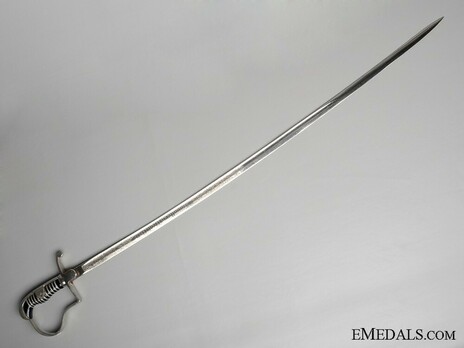
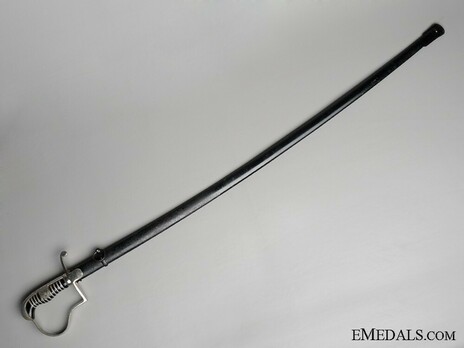
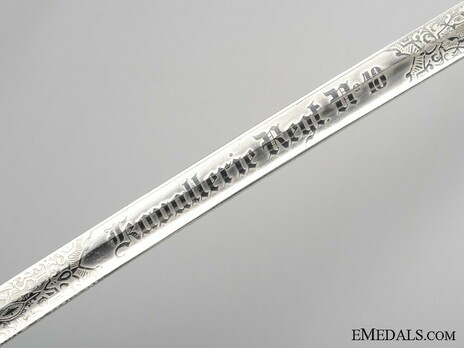
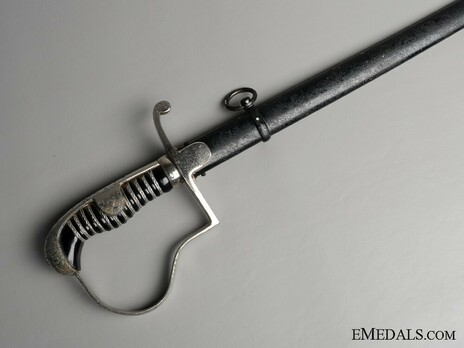
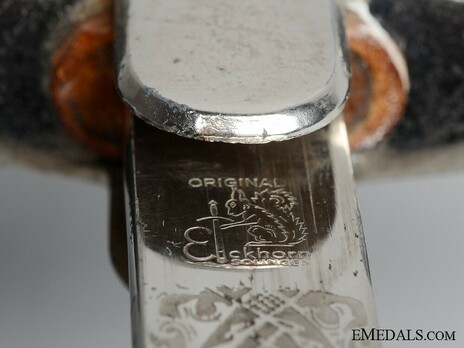
Estimated market value:
This curved sword features a 22 mm wide x 890 mm long steel blade, magnetic, with a dull edge and semi-sharp tip, the blade itself exhibiting beautiful cross graining and light contact and pitting, full-length fuller on both sides, ricasso is maker marked Carl Eickhorn Solingen, with the company's squirrel emblem, ornate engraving on the blade, the ricasso side illustrating right and left-facing eagles, a swastika in their talons, flanking three scenes: a right-facing cavalryman on raised horseback, six right-facing cavalrymen on horseback charging forward and a left-facing officer on horseback, surrounded by ornate lacing and lattice work, the opposite side inscribed "Kavallerie Regt. No 18" in Gothic script flanked by the same ornate lacing and lattice work as that used on the ricasso side, the blade's spine with ornate leafing and complemented with a light brown leather buffer pad. Heavy nickel-plated steel crossguard with quillon, non-magnetic, black synthetic plates with silver wire in the recesses of the ribbed grip, the plates embedded onto either side of the handle and held in place via a long central pin that passes through the supporting guard, that runs from the crossguard and wraps around the pommel, joining on to the opposite end of the crossguard, forming the handle. It weighs 562 grams and measures 1,020 mm in length overall, exhibiting surface wear and gilt loss on the handle, very fine. The scabbard has a durable black painted metal body, magnetic, with flattened u-shaped finial and locket, suspension ring and bracket protruding from the wrap-around loop, weighing 420 grams and measuring 25 mm x 915 mm, exhibiting extensive paint wear and contact marks from active use.
By the time of the Second World War the sword was no longer a combat weapon. Its relevance had been reduced to a symbol of tradition and an indicator of rank and status. It was mostly worn during garrison duty or on the horse during a mounted parade. Because of this it was also considerably smaller and lighter than swords of earlier days that were actually made for combat.
Both the official versions of the Enlisted Man’s Saber and the Officer’s Saber are rather plain and have no visible design motif or outside markings. The difference between the two sabers is mainly in size and weight. The Enlisted Man’s Saber is 5 to 11 cm shorter than the first two sizes of the Officer’s Saber, but 3 cm longer than the third size. It is also 320 to 365 gr heavier.
Unofficial versions made by private companies could be purchased, which was a common occurrence. These came in many varieties and were much more ornate, with pommels in the shape of animal heads, engraved langets, or etched blades.
The designers for the privately purchased unofficial sabers include but may not be limited to: ALCOSO (Alexander Coppel, Solingen); Clemen & Jung; Eickhorn; Richard Herder; F. W. Höller; E&F Hörster; Robert Klaas; Carl Julius Krebs; P. D. Lüneschloss; Ernst Pack & Söhne; Puma; Paul Seilheimer; Emil Voos; Weyersberg, Kirschbaum & Cie. (WKC); Anton Wingen Jr.
All makers are from the city of Solingen.

Comments
Sign in to comment and reply.


Scroll Top